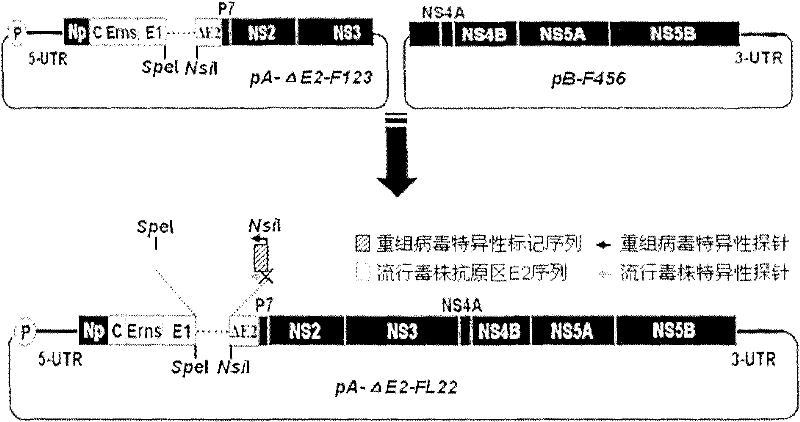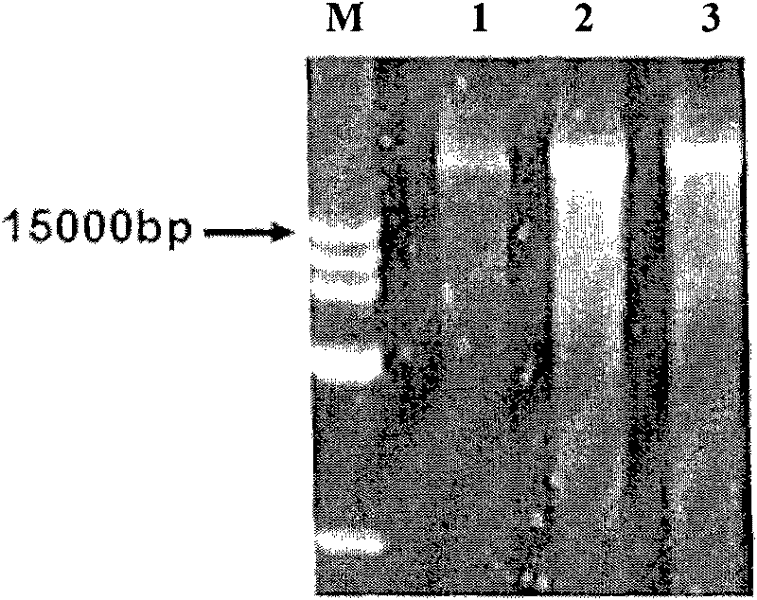Construction and application of E2 gene-based insertable swine fever virus cDNA vector
A kind of swine fever virus, plug-in technology, applied in the direction of recombinant DNA technology, application, genetic engineering, etc.
- Summary
- Abstract
- Description
- Claims
- Application Information
AI Technical Summary
Problems solved by technology
Method used
Image
Examples
Embodiment 1
[0020] Embodiment 1 covers the amplification of CSFV vaccine C strain full-length genome cDNA fragment
[0021] According to the genome sequence of classical swine fever virus, primers with specific restriction sites were designed in the conserved region.
[0022] The primer sequences are as follows:
[0023] F1-upnew: 5-GTATACGAGGTTAGTTCATTCTCG
[0024] F1-lownew: 5-GCCTTGTGCCCCAGTTACT
[0025] F1-upper: 5-AA TCTAGA GTATACGAGGTTAGTTCATTCTC
[0026] F1-lower: 5-AAA ACTAGT AACAGCCATACCACAC
[0027] F2-upnew: 5-GCTTGATAAAAGTATTAAGAGGACAG
[0028] F2-lownew: 5-AACTCGTAAGTGGGCAGTATGA
[0029] F2-upper: 5-ACGG ACTAGT AACTGGGGCACAAGGC
[0030] F2-lower: 5-GGG CTGCAG TGGAAATAAGGTACACGAGAA
[0031] F3-upnew: 5-TTAATAAGGGTGCTGAAGGGAATAGGTGAG
[0032] F3-lownew: 5-CCACATCCAAGTCCGGGAGAGTAA
[0033] F3-upper: 5-AAA GCGGCCGC CTGCAGTGGTAACAAGAT
[0034] F3-lower: 5-GCA GTC GAC GGATCCTCACCACTATAATA
[0035] F4-upnew: 5-GATTAAAGATACCAGTAGAGGAGATGAAGA
[0036] F4-lown...
Embodiment 2
[0049] Embodiment 2 Transformation of the required plasmid for full-length cDNA cloning
[0050] Using pBR322 (purchased from Promega) as a template for transformation, the plasmid pB-CN for cloning the 3′-half length of the CSFV genome was obtained. Specific steps are as follows:
[0051] Apply primer pGEM-U:GGG GGATCCTATAGGGCGAATTGG and pGEM-L:CCG CAAGCTATTTAGGTGACAC amplified the 17lbp fragment containing the plasmid pGEM-5ZF(+) (purchased from Promega) and the multiple cloning site, and introduced restriction sites HindIII and AvaI respectively before and after the fragment. Since the fragment encoding kana resistance in the pBR322 plasmid also contains the corresponding two enzymes, the fragment can be excised by using these two enzymes, and the 171bp fragment is cloned at the corresponding position to obtain the medium-copy plasmid pB- CN.
[0052] The low-copy plasmid pACYC-177 (purchased from NEB Company) was used as a template for transformation to obtain the pl...
Embodiment 3
[0054] The construction of embodiment 3 full-length cDNA vectors
[0055] Assembly of CSFV 5'-half-length: first clone F1, F2 and F3 fragments into plasmid pA or pGEM-5ZF(+) with restriction endonucleases XbaI / SpeI, SpeI / PstI and NotI / SalI respectively to obtain the corresponding Recombinant plasmids F1-pA, F2-pGEM and F3-pGEM. A promoter of T7 RNA polymerase was introduced upstream of the 5'-noncoding region of the genome of the F1 fragment for in vitro transcription of the full-length cDNA. Then, F3 was excised from F3-pGEM with PstI and SalI, and cloned into F2-pGEM with the same enzyme to obtain recombinant plasmid F23-pGEM. Then use SpeI and BamHI to excise F23 from F23-pGEM, and clone F1-pA with the same enzyme to obtain recombinant plasmid F123-pA containing CSFV 5'-half-length.
[0056] Assembly of CSFV 3′-half-length: firstly clone F4 and F5 fragments into plasmid pB with restriction endonucleases BamHI / NcoI and NcoI / NotI, respectively, to obtain corresponding recom...
PUM
 Login to View More
Login to View More Abstract
Description
Claims
Application Information
 Login to View More
Login to View More - R&D
- Intellectual Property
- Life Sciences
- Materials
- Tech Scout
- Unparalleled Data Quality
- Higher Quality Content
- 60% Fewer Hallucinations
Browse by: Latest US Patents, China's latest patents, Technical Efficacy Thesaurus, Application Domain, Technology Topic, Popular Technical Reports.
© 2025 PatSnap. All rights reserved.Legal|Privacy policy|Modern Slavery Act Transparency Statement|Sitemap|About US| Contact US: help@patsnap.com



